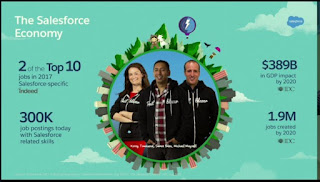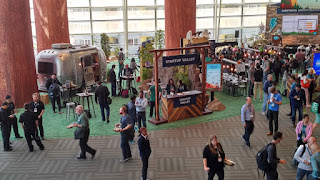No time to watch – here is the 1-2 slide condensation (if the slide doesn’t show up, check here):
Here you go: Always tough to pick the takeaways – but here are my Top 3:
Salesforce DX Beta (open) – Announced at Dreamforce, Salesforce delivered its new CLI for developers to access and run Force.com related developments from a command line. Pulls after changes were demoed under loud applause. Salesforce also delivered on the scratch orgs, making it easier for developers to build / test and experiment with code. Code now can go into multiple orgs – before code was inside of one org (and had to be copied, maintained to go to over orgs, quite a pain). So, a major change in the way how developers build on Salesforce Force.com platform. It is now in open beta - and something a developer in the Salesforce ecosystem should make time to evaluate and get familiarized with.
Salesforce DX Beta (open) – Announced at Dreamforce, Salesforce delivered its new CLI for developers to access and run Force.com related developments from a command line. Pulls after changes were demoed under loud applause. Salesforce also delivered on the scratch orgs, making it easier for developers to build / test and experiment with code. Code now can go into multiple orgs – before code was inside of one org (and had to be copied, maintained to go to over orgs, quite a pain). So, a major change in the way how developers build on Salesforce Force.com platform. It is now in open beta - and something a developer in the Salesforce ecosystem should make time to evaluate and get familiarized with.
 |
| Salesforce Ecosystem Stats |
New Einstein Services – In the spring of AI, a conference with a vendor with AI ambition cannot lack the announcement / deliver of more AI services and Salesforce was no exception, announcing Vision, Sentiment and Intent (based on text input) and Object Machine Learning APIs. Good to see the progress, and the demos shown were good use cases on what developers may build with these new APIs.
 |
| Moscone in TrailheaDX clothes |
Better relationship with standard tools – For a long time the Salesforce development tools stood out of the general realm of the other tools that developers use (on the Force.com platform) – so it was good to see Salesforce changing course, with partnerships with Atlassian and GitHub being the most prominent ones. Developers don’t want to change their tooling – or work with the commonly accepted as best tooling – so this is a key step for Salesforce to make it easier (and more popular) for developers to work on the Salesforce platforms.
In other news…. Salesforce also unveiled a new event system. A demo was showed that applications can now listen to events, and then act on them. Thousands of use cases, to achieve the loose coupling users want from 21st century platforms and applications. This may be the first step for Salesforce to bundle general platform services – think also e.g. identity, data movement, federation, APIs etc. into a single (new! – see below) place.
MyPOV
A good conference for Salesforce developers and administrators. Not only is Salesforce serious about the effort, but also serious about making the necessary learning and training a fun and enjoyable experience. Collecting badges may sound silly at first, but pretty much all the ecosystem is into badge collection, as a way of showing various levels of proficiency inside the Salesforce technology stack and platforms. Salesforce has listened to developers and addressed several ‘sins of the past’ in the current year, with taking the code out of the orgs, with delivering scratch orgs. In many ways, the Salesforce platform feels now more like a platform as opposed to an application vendor’s customization (and extension) environment.On the concern side, Salesforce is the only vendor that maintains two complete application platforms with Force.com and Heroku. Granted, this is less an issue for Salesforce in 2017 than it was eg. in 2012, as the vendor has grown to an impressive scale. But still R&D, marketing, sales etc. efforts go towards to platforms. And both platforms aren’t brand new in 2017, so neither will be the future platform for SaaS / PaaS. Those thoughts have to happen at Salesforce and will likely result in the emergence of a third platform in the coming year. This doesn’t make the R&D challenge easier, but basically on where we stand today, is a certain thing to happen… and better sooner than later for Salesforce customers, developers, administrator and Salesforce itself.
But for now, substantial progress and moves to make the Developer Experience – that’s what DX stands for – a much better, more standard, more normal one. Stay tuned.
Want to learn more? Checkout the Storify collection below (if it doesn’t show up – check here).



